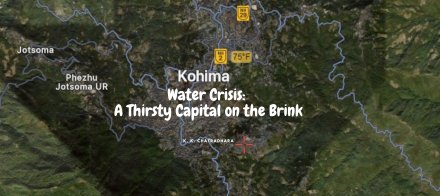 |
On December 31, 2024, Union Minister of Jal Shakti, Shri CR Patil, released the Annual Ground Water Quality Report for 2024, covering the entire country.
This month, "The Water News Collectives" is dedicated to looking into the report from a Northeastern states' lens.
The Annual Ground Water Quality Report – 2024 is produced to assess and document the status of groundwater quality across various regions, identify potential contaminants, and inform stakeholders about the health of water resources. This report helps in making informed decisions for water management, policy formulation, and environmental protection.
National Highlights
- Groundwater Recharge: India's total annual groundwater recharge is estimated at 446.90 billion Cubic Meter (BCM), with a significant increase of 15 BCM from the 2017 assessment.
- Groundwater Exploitation: The annual groundwater exploitation for all uses is 245.64 BCM, with an average level of exploitation at 60.47%.
- Regional Variability: Some states like Arunachal Pradesh and Mizoram have 100% of their water samples meeting the BIS standards, while others like Rajasthan, Haryana, and Andhra Pradesh face widespread contamination.
- Contaminants of Concern: The report identifies nitrate, fluoride, arsenic, and uranium as specific contaminants of concern in various regions.
Northeastern States Highlights
- Assam: Groundwater quality is excellent for irrigation purposes, with a pH value ranging from 7.5 to 9.0.
- Arunachal Pradesh: No significant decline in water levels during pre- and post-monsoon seasons, and groundwater quality is excellent, with no major contaminants detected.
- Nagaland: Net groundwater availability is 9.66 million cubic meters (mcm), and groundwater quality is generally good, with no significant contamination.
- Meghalaya: Groundwater quality is excellent, with 100% of samples meeting BIS standards for drinking water.
- Sikkim: Groundwater quality is generally good, with most samples meeting BIS norms for drinking water.
- Manipur: Total annual groundwater availability is assessed, considering various uses like irrigation and domestic sectors.
- Mizoram: Groundwater quality is excellent, with 100% of samples meeting BIS standards for drinking water.
- Tripura: Total annual groundwater availability is 164.59 million cubic meters (MCM), and groundwater quality is generally good, with most samples meeting BIS norms for drinking water.
The Annual Ground Water Quality Report 2024 was recently released by the Union Minister of Jal Shakti. This report is a comprehensive analysis of India's groundwater quality, providing insights into the country's groundwater resources.
Here are some key highlights from the report:
- Groundwater Recharge: The total annual groundwater recharge in India is estimated at 446.90 billion Cubic Meter (BCM), with a significant increase of 15 BCM from the 2017 assessment.
- Groundwater Exploitation: The annual groundwater exploitation for all uses is 245.64 BCM, with an average level of exploitation at 60.47%.
- Regional Variability: Some states like Arunachal Pradesh and Mizoram have 100% of their water samples meeting the BIS standards, while others like Rajasthan, Haryana, and Andhra Pradesh face widespread contamination.
- Contaminants of Concern: The report identifies nitrate, fluoride, arsenic, and uranium as specific contaminants of concern in various regions.
The report emphasizes the need for sustainable groundwater management practices, considering the increasing demand for groundwater resources.
Northeastern states: The Annual Groundwater Quality Report 2024 has some great news for the Northeastern states. According to the report, the groundwater quality in these states, including Assam, has been rated as "excellent" for irrigation purposes.
This is a significant finding, indicating that the region's groundwater resources are well-suited to support agricultural activities. The report's assessment is based on a comprehensive evaluation of groundwater quality, using internationally recognized methods and a standardized approach.
The Central Ground Water Board (CGWB) compiled the report, which analysed data from over 15,200 monitoring locations across the country, including detailed assessments at 4,982 trend stations.
Assam: According to the Annual Ground Water Quality Report 2024, Assam's groundwater quality is excellent for irrigation purposes. The report also mentions that the pH value of groundwater in Assam ranges from 7.5 to 9.0, making it safe for drinking, industrial, and agricultural purposes. However, it's worth noting that some parameters like iron, fluoride, and arsenic are present in the groundwater, with fluoride being found only in deeper aquifers.
Arunachal Pradesh's groundwater report is quite impressive. The state has no significant decline in water levels during pre and post-monsoon seasons ¹. Moreover, there are no quality hazards in Arunachal Pradesh, as listed in the Groundwater Estimation Committee (GEC) 2015 report.
In terms of groundwater quality, the report mentions that the water is slightly alkaline, with the presence of some chemicals. However, overall, the state's groundwater quality is excellent, with no major contaminants detected.
It's worth noting that the Central Ground Water Board (CGWB) has conducted extensive studies on Arunachal Pradesh's groundwater resources, including aquifer mapping and water quality analysis. These studies provide valuable insights into the state's groundwater management and sustainability.
Nagaland's groundwater report presents a mixed picture. According to the report on dynamic groundwater resources, the state has a net groundwater availability of 9.66 million cubic meters (mcm). However, the gross annual draft is not explicitly mentioned.
The Central Ground Water Board (CGWB) has conducted studies on Nagaland's groundwater resources, including aquifer mapping and water quality analysis. These studies provide valuable insights into the state's groundwater management and sustainability.
In terms of groundwater quality, the report does not mention any significant contamination. However, it highlights the need for sustainable groundwater management practices to ensure the long-term availability of this vital resource.
The Nagaland Water Policy-2016 also emphasizes the importance of groundwater conservation and management. The policy aims to promote sustainable water use practices and protect the state's water resources for future generations.
Meghalaya's groundwater report highlights the state's unique geology, with sandstones forming potential aquifers locally. The groundwater is found to occur under confined to unconfused aquifer conditions within 300 meters.
The Central Ground Water Board (CGWB) has conducted studies on Meghalaya's groundwater resources, including aquifer mapping and water quality analysis. These studies provide valuable insights into the state's groundwater management and sustainability.
Some of the key initiatives mentioned in the report include:
- Development of Springs: Development of springs and their catchments in hilly areas for sustainability ³.
- National Aquifer Mapping & Management Programme (NAQUIM): Reports prepared by NAQUIM provide valuable insights into Meghalaya's groundwater resources.
Overall, the report emphasizes the importance of sustainable groundwater management practices in Meghalaya to ensure the long-term availability of this vital resource.
Sikkim's groundwater report highlights the state's unique geological setup, with the Himalayan orogeny resulting in diverse rock formations. The report notes:
- Groundwater Occurrence: Groundwater in Sikkim occurs in the form of springs, which are recharged by precipitation.
- Quality: The report mentions that the groundwater quality in Sikkim is generally good, with most of the samples meeting the Bureau of Indian Standards (BIS) norms for drinking water.
- Challenges: The report highlights the challenges faced by Sikkim in managing its groundwater resources, including the state's rugged terrain, limited infrastructure, and climate change.
- Initiatives: The report mentions various initiatives taken by the government to promote sustainable groundwater management in Sikkim, including the implementation of the Sikkim Ground Water (Regulation and Control of Development and Management) Act, 2013.
Manipur's groundwater report highlights several key points. The state's total annual groundwater availability is assessed, considering various uses like irrigation and domestic sectors.
- In terms of aquifer management, a report on Imphal East District focuses on irrigation for agriculture, elaborating on the prevailing aquifer system and its management plan.
- The Ground Water Information Booklet for Imphal West District provides valuable insights into the district's groundwater scenario, including its geology, hydrology, and water quality.
- Additionally, the Dynamic Groundwater Resources of Manipur 2017 report presents a block-level estimation of the state's groundwater resources.
Mizoram's groundwater report presents a positive picture. Here are some key highlights:
- Groundwater Quality: The report mentions that 100% of the groundwater samples collected from Mizoram meet the Bureau of Indian Standards (BIS) norms for drinking water.
- No Contamination: Unlike many other states, Mizoram's groundwater is not contaminated with fluoride, arsenic, or other hazardous substances.
- Sustainable Management: The report highlights the need for sustainable groundwater management practices in Mizoram to ensure the long-term availability of this vital resource.
- Initiatives: The government of Mizoram has initiated various programs to promote sustainable groundwater management, including the implementation of the Mizoram Ground Water (Regulation and Control of Development and Management) Act, 2013.
Tripura's groundwater report highlights several key points:
- Groundwater Availability: The report mentions that Tripura has a total annual groundwater availability of 164.59 million cubic meters (MCM).
- Stage of Extraction: The stage of groundwater extraction in Tripura is 34.31%, indicating a relatively low level of extraction.
- Quality: The report notes that the groundwater quality in Tripura is generally good, with most of the samples meeting the Bureau of Indian Standards (BIS) norms for drinking water.
- Initiatives: The government of Tripura has initiated various programs to promote sustainable groundwater management, including the implementation of the Tripura Ground Water (Regulation and Control of Development and Management) Act, 2013.
End of the December 2024 update…
North East India Water Talk Water News Collectives (November 2024)
We are Water, and we keep an eye on water!
Compiled by: K. K. Chatradhara
This newsletter is a monthly publication of the North East India Water Talks (NEIWT). We cover all aspects of water, including reports, paper clips, research papers, incidents, and activities done by different actors, such as government institutions, non-governmental organizations, etc.
What is published here is not the position of NEIWT.
Each month's first day of news will feature the latest happenings from the previous month.
Published: 3rd Jan, 2025


